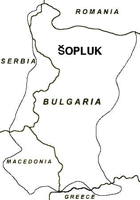
|
The Society of Folk Dance Historians (SFDH) Šopluk
[
Home |
About |
Encyclopedia | CLICK AN IMAGE TO ENLARGE |

|
BACKGROUND
Information: Šopluk is a mesoregion, roughly where Bulgaria, Serbia, North Macedonia, and Greece meet. In Serbia the term Šop has always denoted highlanders.
According to Institute for Balkan Studies, the Šopluk was the mountainous area on the borders of Serbia, Bulgaria, and North Macedonia, of which boundaries are quite vague. Šopluk was used by Bulgarians to refer to the borderlands of Bulgaria, the inhabitants were called Šopi. In Bulgaria, the Šopi designation is currently attributed to villagers around Sofia.
 Most of the area traditionally inhabited by the Šopi is in Bulgaria. The majority of the Šopi (those in Bulgaria, as well the territories which were part of Bulgaria before 1919) identify themselves as Bulgarians, while those in the pre-1919 territory of Serbia are identified as Serbians, and those in North Macedonia are identified as Macedonians.
Most of the area traditionally inhabited by the Šopi is in Bulgaria. The majority of the Šopi (those in Bulgaria, as well the territories which were part of Bulgaria before 1919) identify themselves as Bulgarians, while those in the pre-1919 territory of Serbia are identified as Serbians, and those in North Macedonia are identified as Macedonians.
The Bulgarian scholars put Shopi as a subgroup of the Bulgarian ethnos. As with every ethnographic group, the Bulgarian Academy notes, the Šopi in Bulgaria consider themselves the true and most pure of the Bulgarians, just as the mountaineers around Turnovo claim their land as true Bulgaria from time immemorial, etc.
Many Serbian scholars put the Šopi as a subgroup of the Serbian ethnos, claiming that the group is closer to Serbs than Bulgarians culturally and linguistically, calling it a Serbian population in a foreign (Bulgarian) area, at the Serbo-Bulgarian border.
The Šopi have a very original and characteristic folklore. The traditional male costume of the Šopi is white, while the female costumes are diverse. White male costumes are spread at the western Šopluk. The hats they wear are also white and tall (called gugla). Traditionally Šopi costume from the Kyustendil region are in black and they are called Chernodreshkovci (blackcoats). Some Šop women wear a special kind of sukman called a litak, which is black, generally is worn without an apron, and is heavily decorated around the neck and bottom of the skirt in gold, often with great quantities of gold-colored sequins. Embroidery is well developed as an art and is very conservative.
Language: Šopski
Religion: Predominantly Eastern Orthodox Christianity
This page © 2018 by Ron Houston.
Please do not copy any part of this page without including this copyright notice.
Please do not copy small portions out of context.
Please do not copy large portions without permission from Ron Houston.